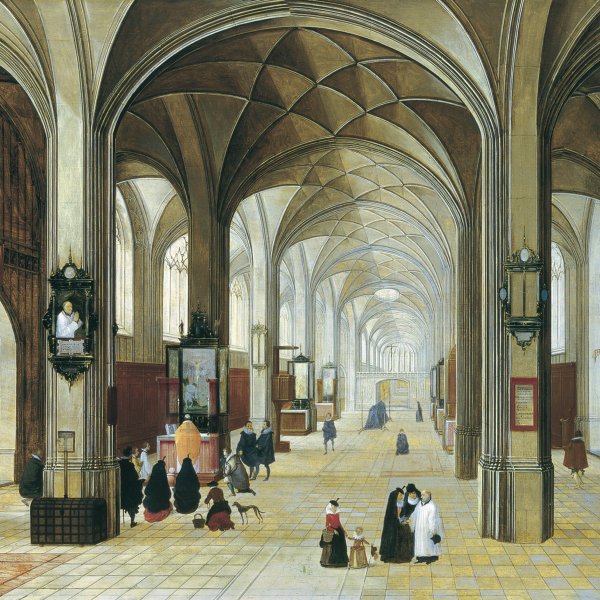Peeter Neeffs I
Antwerp (?), ca. 1578 (?) -Antwerp, before 1661
The biography of this 17th-century painter is difficult to reconstruct as little information is known regarding his life. Peeter Neeffs I was born around 1578, probably in Antwerp where his parents lived and where his siblings were born. Little is known of his training, and it has been suggested that he trained with Hendrick van Steenwijk the Elder or his son due to stylistic similarities, particularly with Steenwijk the Younger. In 1609 he is first registered as an independent master with the Antwerp painters’ guild but his first known work, Interior of a Gothic Church (Gemäldegalerie Alte Meister, Dresden), is dated 1605. In 1612 Neeffs married Maria Lauterbeens, with whom he had five children, of whom two, Ludovico and Peeter the Younger, became painters and worked in their father’s studio. Stylistically and iconographically, Peeter Neeffs II’s work is so close to that of his father that it is difficult to tell them apart, resulting in considerable confusion with regard to their attribution.
Peeter Neeffs I specialised in interiors of churches, in particular Antwerp cathedral, the building that he most often depicted. Many of his works are artificially lit, nocturnal scenes that are clearly inspired by those of Hendrick van Steenwijk. Such works allowed Neeffs to focus on a study of different effects of artificial light in an enclosed space. The artist was noted for his ability to convey subtle transitions of light and shade, achieved through the use of delicate tonalities and soft gradations of colour. Neeffs’ works are animated with figures painted by other artists, including Frans Francken II, Frans Francken III, Jan Brueghel I, Sebastian Vrancx, Adriaen van Stalbemt, David Teniers II and Gonzales Coques. The date of his death is unknown but is thought to have been between 1656, when he is last documented, and 1661, when Cornelis de Bie in his Gulden cabinet refers to him as already deceased.
Peeter Neeffs I specialised in interiors of churches, in particular Antwerp cathedral, the building that he most often depicted. Many of his works are artificially lit, nocturnal scenes that are clearly inspired by those of Hendrick van Steenwijk. Such works allowed Neeffs to focus on a study of different effects of artificial light in an enclosed space. The artist was noted for his ability to convey subtle transitions of light and shade, achieved through the use of delicate tonalities and soft gradations of colour. Neeffs’ works are animated with figures painted by other artists, including Frans Francken II, Frans Francken III, Jan Brueghel I, Sebastian Vrancx, Adriaen van Stalbemt, David Teniers II and Gonzales Coques. The date of his death is unknown but is thought to have been between 1656, when he is last documented, and 1661, when Cornelis de Bie in his Gulden cabinet refers to him as already deceased.



